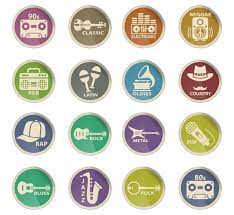
Unveiling the Melodic Tapestry: Exploring the World of Music Genres
Music Genres: A Kaleidoscope of Melodic Diversity
Music has the remarkable ability to transcend boundaries, evoke emotions, and connect people from all walks of life. One of the ways in which music achieves this is through its vast array of genres, each with its own distinct characteristics and appeal. From the soulful melodies of blues to the energetic beats of hip-hop, music genres offer us a kaleidoscope of sonic diversity.
Genres can be thought of as musical categories that group together similar styles, themes, and techniques. They provide a framework for artists and listeners alike to explore different musical expressions and find their own unique tastes. Let’s delve into some popular genres that have shaped the landscape of music throughout history:
- Rock: With its roots in the 1950s, rock music has become a global phenomenon. From the rebellious spirit of early rock ‘n’ roll to the electrifying guitar solos of heavy metal, rock encompasses a wide range of sub-genres that cater to various tastes.
- Pop: Known for its catchy hooks and infectious melodies, pop music dominates charts worldwide. It embraces a broad spectrum of styles, from bubblegum pop to electronic pop and everything in between.
- Hip-Hop: Originating from African-American communities in the 1970s, hip-hop has evolved into a cultural movement with its own distinctive style. Rapping, DJing, beatboxing, and graffiti are integral elements that define this genre.
- Jazz: Born in late 19th-century America, jazz is often regarded as one of America’s greatest contributions to music. Its improvisational nature and complex harmonies continue to captivate audiences around the globe.
- Blues: Rooted in African-American culture and born out of struggle and hardship, blues music expresses raw emotions through soulful vocals and melancholic guitar riffs. It serves as a foundation for many other genres like rock and jazz.
- Country: Originating from the rural regions of the United States, country music tells stories of love, heartbreak, and the simple joys of life. It embraces various sub-genres such as traditional country, outlaw country, and country-pop.
- Electronic: With its origins in experimental music, electronic music relies heavily on synthesizers, drum machines, and computer-generated sounds. From ambient to techno to dubstep, electronic music continues to push boundaries and redefine what is possible in sound creation.
- R&B/Soul: Rooted in African-American culture, rhythm and blues (R&B) and soul music are known for their heartfelt lyrics and captivating vocal performances. These genres have influenced countless artists across different musical landscapes.
- Classical: With a rich history dating back centuries, classical music represents some of humanity’s most profound artistic achievements. From symphonies to operas to sonatas, this genre showcases the mastery of composers throughout time.
These are just a few examples among an extensive range of genres that exist today. Music genres not only provide us with entertainment but also serve as a means of personal expression and cultural identification. They allow us to explore different perspectives, emotions, and experiences through the universal language of music.
In conclusion, music genres offer us a vibrant tapestry of melodies that enrich our lives in countless ways. Whether we find solace in the soothing tunes of jazz or unleash our energy through the pulsating rhythms of hip-hop, there is a genre out there for everyone to enjoy. So let’s embrace this sonic diversity and let the power of music continue to unite us all.
Exploring Music Genres: 6 Frequently Asked Questions Answered
- What are the different types of music genres?
- What is the most popular music genre?
- How do you classify a particular piece of music by genre?
- What are the characteristics of each music genre?
- How have music genres evolved over time?
- Are there any new emerging music genres?
What are the different types of music genres?
There are numerous music genres that span across various styles, cultures, and time periods. Here is a list of some popular and influential genres:
- Rock: This genre encompasses a wide range of styles, including classic rock, alternative rock, punk rock, heavy metal, and more.
- Pop: Known for its catchy melodies and broad appeal, pop music dominates the charts with artists like Taylor Swift, Ariana Grande, and Justin Bieber.
- Hip-Hop/Rap: Originating from African-American communities in the 1970s, hip-hop is characterized by its rhythmic beats and spoken word lyrics.
- Jazz: With its improvisational nature and complex harmonies, jazz emerged in the late 19th century and has evolved into various sub-genres like bebop, swing, and fusion.
- Blues: Rooted in African-American culture, blues music expresses emotions through soulful vocals and guitar instrumentation.
- Country: Originating from rural America, country music tells stories of love, heartbreak, and everyday life experiences.
- Electronic/Dance: This genre relies heavily on electronic instruments to create a wide range of sounds suitable for dancing or listening pleasure.
- R&B/Soul: Known for its smooth vocals and emotional lyrics, R&B (rhythm and blues) and soul music have influenced many other genres.
- Classical: Classical music represents centuries of compositions by renowned composers such as Bach, Mozart, Beethoven, and more.
- Reggae: Originating from Jamaica in the late 1960s, reggae is known for its distinctive rhythms and social commentary lyrics.
- Folk: Folk music reflects cultural traditions through storytelling lyrics accompanied by acoustic instruments.
- Gospel: Gospel music originated in African-American churches and is characterized by its uplifting lyrics rooted in Christian faith.
- Latin: Latin music encompasses various styles such as salsa, bachata, reggaeton, and more, originating from Latin American countries.
- Funk: With its emphasis on strong basslines and syncopated rhythms, funk music is known for its infectious grooves.
- World: World music encompasses a wide range of genres from different cultures worldwide, blending traditional and contemporary sounds.
These are just a few examples among the vast array of music genres that exist today. Each genre carries its own unique characteristics and appeal, catering to diverse musical tastes and preferences.
What is the most popular music genre?
Determining the most popular music genre can be subjective and can vary depending on factors such as geographical location, cultural preferences, and trends over time. However, currently, pop music is often considered one of the most popular and commercially successful genres worldwide. Pop music’s catchy melodies, relatable lyrics, and broad appeal have contributed to its widespread popularity among a diverse range of listeners. Additionally, other genres like hip-hop and rock also enjoy significant popularity and have a strong influence on contemporary music culture. It’s important to note that the popularity of genres can fluctuate over time as new styles emerge and tastes evolve.
How do you classify a particular piece of music by genre?
Classifying a particular piece of music by genre can be subjective and may vary depending on individual interpretations. However, there are certain elements and characteristics that can help in determining the genre of a song:
- Musical Elements: Pay attention to the instrumentation, rhythm, tempo, and overall sound of the song. Different genres often have distinct musical features. For example, rock music typically includes electric guitars, drums, and strong beats, while electronic music relies heavily on synthesizers and computer-generated sounds.
- Vocals: Consider the style of vocals used in the song. Is it melodic singing? Rap? Screaming? The vocal delivery can provide clues about the genre.
- Lyrics and Themes: Analyze the lyrical content and themes explored in the song. Genres like country often focus on storytelling or personal experiences, while genres like hip-hop may address social issues or personal expression.
- Historical Context: Understanding the historical context of a particular genre can also help classify a song. For instance, if a piece draws heavily from blues scales and features soulful vocals, it might fall under blues or soul music.
- Influences: Take note of any noticeable influences or similarities to well-known artists or songs within specific genres. This can provide insights into where a particular piece might fit.
- Reception and Industry Classification: Consider how industry professionals or critics classify the music in question. Music platforms often assign genres to songs for organizational purposes, although these classifications may not always align with individual interpretations.
It’s important to remember that many songs incorporate elements from multiple genres or blend different styles together, making classification more challenging at times. Ultimately, classifying music by genre is subjective to some extent and can involve personal interpretation based on one’s knowledge and familiarity with various genres.
What are the characteristics of each music genre?
While it is challenging to capture all the characteristics of each music genre in a brief article, here is a general overview of some key characteristics associated with popular music genres:
Rock:
– Emphasis on guitar-driven sound, often featuring prominent electric guitar riffs and solos.
– Strong emphasis on rhythm and energetic performances.
– Wide range of sub-genres, including classic rock, alternative rock, punk rock, and more.
Pop:
– Catchy melodies and hooks that are easy to remember.
– Emphasis on radio-friendly production and accessibility.
– Often features electronic elements and collaborations with various artists.
Hip-Hop:
– Dominated by rhythmic vocals (rap) over beats created through sampling or electronic production.
– Lyrically focused on personal experiences, social issues, storytelling, or boasting.
– Incorporates elements such as scratching, beatboxing, and DJ techniques.
Jazz:
– Improvisation plays a significant role in performances.
– Complex harmonies and chord progressions.
– Focus on instrumental virtuosity and ensemble interaction.
Blues:
– Expressive vocal delivery often accompanied by soulful guitar playing.
– Use of specific chord progressions (such as the 12-bar blues).
– Lyrics typically explore themes of heartbreak, struggle, or personal experiences.
Country:
– Often characterized by storytelling lyrics about love, relationships, rural life, or patriotism.
– Incorporates acoustic guitars, fiddles, banjos, and other traditional instruments.
– Various sub-genres ranging from traditional country to country-pop.
Electronic:
– Reliance on synthesizers and electronic instruments for sound creation.
– Emphasis on repetitive beats and basslines.
– Wide range of sub-genres like techno, house, trance, dubstep with varying tempos and textures.
R&B/Soul:
– Smooth vocal delivery with an emphasis on emotion and soulfulness.
– Use of melodic hooks and harmonies.
– Often explores themes of love, relationships, and personal experiences.
Classical:
– Complex compositions with multiple movements.
– Orchestral arrangements featuring various instruments.
– Emphasis on dynamics, structure, and harmonic complexity.
It’s important to note that these characteristics can vary within each genre, and many genres have evolved over time to incorporate elements from others. Additionally, there are numerous sub-genres and regional variations within each genre that further contribute to the diversity of musical expression.
How have music genres evolved over time?
Over time, music genres have undergone significant evolution and transformation, reflecting changes in society, technology, and cultural influences. Here are some key ways in which music genres have evolved:
- Fusion and Hybridization: As cultures have become more interconnected, genres have started to blend together, giving rise to new hybrid styles. This fusion of different musical traditions has led to the creation of genres like world music, fusion jazz, and electronic dance music (EDM), which incorporate elements from various cultures and genres.
- Technological Advancements: The development of new musical instruments, recording techniques, and production tools has had a profound impact on the evolution of music genres. From the introduction of electric guitars in rock ‘n’ roll to the use of synthesizers in electronic music, technology has expanded the sonic possibilities for artists and shaped the sound of different genres.
- Cultural Movements: Music often reflects the social and political climate of its time. Various cultural movements such as the civil rights movement, counterculture movements of the 1960s, punk movement, or LGBTQ+ rights movements have influenced the emergence of new genres or sub-genres that express specific ideologies or identities.
- Cross-Pollination: Artists from different genres frequently collaborate and borrow elements from one another’s styles. This cross-pollination has led to genre crossovers and innovations. For example, collaborations between hip-hop artists and pop singers have resulted in chart-topping hits that blend rap verses with catchy pop choruses.
- Evolution within Genres: Even within a single genre, there is constant evolution as artists experiment with new sounds and push boundaries. Sub-genres emerge as artists explore different variations within a broader genre category. For instance, within rock music itself, we see sub-genres like alternative rock, grunge rock, indie rock, and many more.
- Globalization: The ease of access to global music through digital platforms has exposed listeners to a wider range of genres from different parts of the world. This globalization has led to the popularity and adoption of genres like reggae, salsa, Afrobeat, K-pop, and more in various regions outside their cultural origins.
- Changing Trends and Tastes: Music genres are not static; they respond to changing trends and tastes. What is popular today may be different from what was popular a decade ago. New genres emerge as artists and audiences seek fresh sounds and experiences.
It’s important to note that while music genres evolve, they also retain their core elements and influences from their origins. The evolution of music genres is a testament to the creativity and adaptability of artists throughout history, as well as the dynamic nature of human culture.
Are there any new emerging music genres?
Indeed, the world of music is constantly evolving, and with it comes the emergence of new genres that push boundaries and challenge traditional conventions. Here are a few examples of relatively new and emerging music genres:
- Trap: Originating in the early 2000s, trap music has gained significant popularity in recent years. It combines elements of hip-hop, electronic music, and Southern rap to create a distinctive sound characterized by heavy basslines, rapid hi-hats, and dark lyrical themes.
- Afrobeat: Emerging from West Africa in the 1970s but gaining global recognition in recent years, Afrobeat blends traditional African rhythms with jazz, funk, and highlife influences. It often features infectious grooves, vibrant horn sections, and socially conscious lyrics.
- EDM (Electronic Dance Music): While electronic music has been around for decades, EDM as a genre has experienced a surge in popularity over the past decade. EDM encompasses various sub-genres such as house, techno, dubstep, and trance. Known for its energetic beats and infectious melodies, EDM dominates festivals and clubs around the world.
- K-pop: Originating from South Korea but gaining international acclaim in recent years, K-pop is a genre that combines catchy pop melodies with elements of hip-hop, R&B, electronic music, and more. It often features visually stunning performances accompanied by synchronized choreography.
- Vaporwave: Emerging in the early 2010s as an internet-born genre with nostalgic undertones, vaporwave incorporates samples from ’80s and ’90s pop songs or elevator music to create dreamy atmospheres. It often utilizes slowed-down tempos and glitchy aesthetics to evoke a sense of nostalgia or irony.
- Alternative R&B: This genre blends elements of contemporary R&B with influences from other genres like indie rock or electronic music. Alternative R&B artists often experiment with unconventional song structures or production techniques to create a unique and distinctive sound.
These are just a few examples of the many new and emerging music genres that continue to evolve and shape the musical landscape. As artists push creative boundaries and fuse different styles together, we can expect even more exciting genres to emerge in the future, reflecting the ever-changing tastes and preferences of listeners worldwide.


